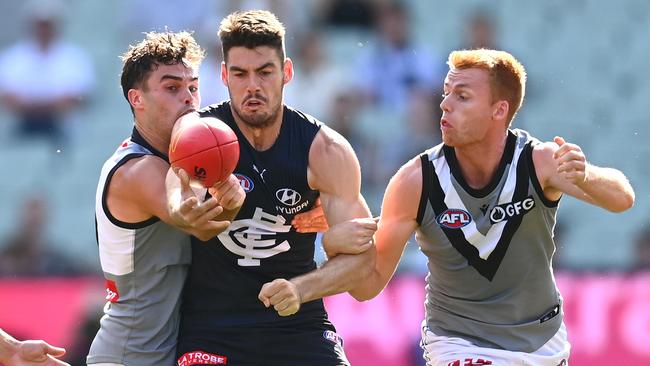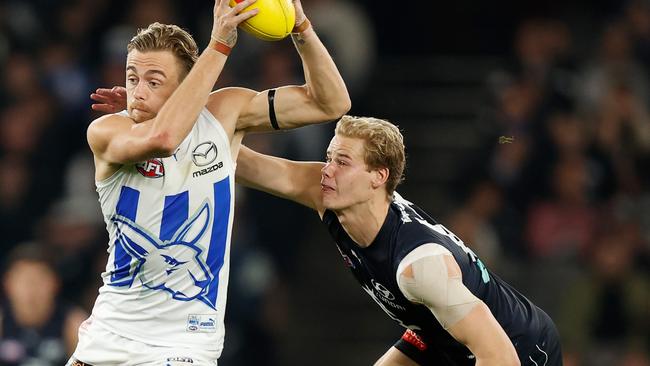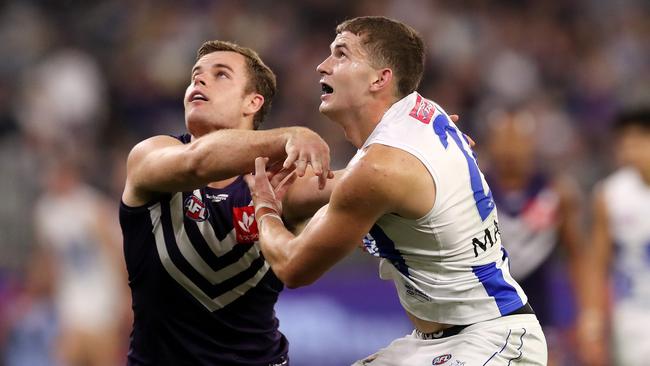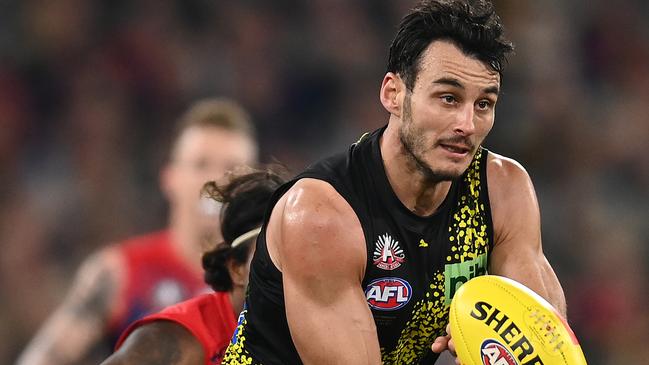AFL 2022: Mick McGuane ranks the best and worst recruits of the season
Some fresh faces have exceeded expectations at their new clubs. But it’s very different for a few others. Mick McGuane ranks the best – and worst – recruits of 2022.
AFL
Don't miss out on the headlines from AFL. Followed categories will be added to My News.
It wasn’t exactly a bumper trade and free agency period last year, but there have been a few genuine gems that have been uncovered by recruiters.
On the flip side, a high-profile recruits have been underwhelming so far.
Here are Mick McGuane’s recruiting ticks and crosses from player movement over the off-season.
Stream every match of every round of the 2022 Toyota AFL Premiership Season Live & Ad-Break Free In-Play on Kayo. New to Kayo? Try 14-Days Free Now >

TICKS
1. George Hewett (Carlton)
The new Blues midfielder takes the cake as recruit of the year so far.
It has not just been Hewett’s work with ball in hand that sets him apart, but also the leadership and on field accountability that he has brought to a Carlton midfield group that’s on fire.
At times he looks like a traffic cop out on the field, organising and directing teammates and putting on show his defend-first mindset.
Hewett is very clean around stoppages and ranks second to Patrick Cripps at the Blues for clearances with 47, while also possessing great balance with his outside game to shoot off a quick handball and kickstart Carlton’s offence.
His average of 7.2 score involvements – which rates above average – shows that whenever he’s involved in a chain, he generally makes good decisions with the ball.
For a player to walk into a new environment and average 30 disposals across the first eight rounds is quite incredible.
Carlton’s vision to get Hewett to the club has certainly been justified.
2. Jordan Dawson (Adelaide)
The Crows would be tickled pink that the former Swan chose them over arch rival Port Adelaide when he was looking at a move back to South Australia.
Dawson famously took the responsibility and kicked the winning goal after the siren in the Showdown in Round 3 and is a player who is evolving as a leader before our eyes.
The Crows clearly needed better ball users and Dawson has always been a prolific ball-winner, particularly on the outside, with his sublime kicking skills clearly his biggest strength.
He is averaging 570 metres gained – rated elite – from an average of 24 disposals a game.
Dawson also reads the game well and will put his body on the line when required, averaging 5.9 intercept possessions.
Having just turned 25, Dawson’s future is going to be set in stone at the Crows, possibly in a leadership capacity down the track.

3. Will Brodie (Fremantle)
This is shaping as Jarryd Lyons all over again.
Just like Lyons, the Gold Coast Suns were happy to hand over Brodie for next to nothing and he has instantly become a regular fixture in a Fremantle midfield that is flying.
It is a credit to the Dockers’ recruiting team for identifying Brodie – and a credit to the player himself for seizing the opportunity with both hands.
Brodie has certainly complemented Fremantle’s midfield group and is allowing other players to get to work on the outside with his fierce contest work.
He’s averaging 12.1 contested possessions – ranked above average – from 27.1 disposals a game, along with a team-high 5.8 clearances.
Brodie clearly knows how to win his own footy in the middle of the ground but also has a strong defensive mindset and has laid the third-most tackles of any Dockers player this year.
Not bad for a player who was picked for only six games across the past two years for the struggling Suns.
4. Adam Cerra (Carlton)
In a Blues midfield that now bats quite deep, Cerra is flying under the radar a little bit.
He’s probably fourth in line at the moment behind the likes of Patrick Cripps, George Hewett and Sam Walsh.
However, the former Docker is still playing an important role and is just as capable of being a starting midfielder, having averaged 26.4 disposals with his new club.
Cerra has always had very clean hands, but the one element I felt he had to improve on this year was his kicking going inside 50.
Based on his game against Adelaide last week – where Cerra logged 10 inside-50s – there looks to have been a marked improvement in that area.
He had four score assists in that game among eight score involvements.
Cerra’s toughness and appetite for the contest is also widely underrated.
He’s averaging five tackles a game, ranking him second behind only Cripps at Carlton.

5. Tyson Stengle (Geelong)
It’s looking like a case of third time lucky for Stengle.
Originally drafted to Richmond, he made a move to Adelaide which was derailed by off-field issues and found himself on the footy scrap heap playing for Woodville West Torrens in the SANFL last season.
Despite his impressive form last year, every AFL club overlooked him except for the Cats, who clearly backed their culture to keep him in check.
Stengle has complemented Geelong’s forward line brilliantly this season, but the best thing about his year to date is that he’s not just hovering as a forward 50 player.
He’s prepared to get up the ground so he can be the money-kick player going inside-50 to set up other teammates, on the back of using his footy smarts to find space.
Stengle has had the third-most inside-50s for the Cats this year, while he is also averaging two goals a game which is a terrific return for a small forward.
Stengle would understand this is his last chance to make something of his AFL career and he’s got too much talent to throw that away again.
6. Levi Casboult (Gold Coast)
The former Carlton big man was thrown a football lifeline in last year’s rookie draft and the Suns have got some real bang for buck for him so far.
After Ben King went down with a season-ending knee injury, Gold Coast had little choice but to lean on Casboult and fellow recruit Mabior Chol to spearhead their attack alongside Jack Lukosius.
Many – including myself – thought Casboult would struggle to find a new AFL home and consistently perform at the highest level.
However, he has clearly proven the doubters wrong on the back of Gold Coast’s gamble.
To have a target of his stature inside forward 50 has been a key reason why the Suns have been competitive this year.
Teammates are confidently targeting Casboult, who is averaging 3.1 forward 50 marks and 2.3 goals a game.
Coaches are also trusting him, which is why he has played 95 per cent game time this year.
Casboult is clearly earning his pay packet considering his performances to this point of the season.

CROSSES
1. Hugh Greenwood (North Melbourne)
A high-profile midfielder, Greenwood left Adelaide to go to the Gold Coast and then found his way to North Melbourne on the back of a coach-inspired move.
David Noble wanted him and thought he could be an A Grade midfielder for the Kangaroos, but he’s been a long way from that so far.
Greenwood is averaging 18.3 disposals (below average), a career-low 9.5 contested possessions (average) and 3.4 clearances (below average).
Greenwood has never been a great metres gained player because he handballs more than he kicks, but his average of 172m gained is poor in anyone’s language and I question his creativity with the ball.
With Ben Cunnington still sidelined, the Kangaroos desperately need someone in the midfield to step up and say ‘follow me’.
Greenwood, along with Jy Simpkin, should be driving that midfield group.
However, his performances clearly haven’t lived up to the hype surrounding his recruitment.
2. Callum Coleman-Jones (North Melbourne)
The former Richmond forward was a highly-touted recruit who chose to leave a club with a very sound winning culture.
We thought he was joining the Kangaroos to become the relief ruckman for Todd Goldstein as well as supporting Nick Larkey in attack.
As it has turned out, Tristian Xerri has shared most of the ruck responsibility with Goldstein and Coleman-Jones has only played three of eight games.
For a struggling team that is aching for some more targets in attack, there must be something the coaches aren’t loving about Coleman-Jones’ game to have left him in the VFL for weeks on end after Round 1.
He has returned to the senior side the past two weeks, but from three AFL games he has not taken a single mark inside-50 and has kicked only two goals.
Big men take time, but Coleman-Jones is in his fifth season and is not on his L-plates anymore.
Have the Kangaroos really got the player they thought they would get?

3. Jeremy Finlayson (Port Adelaide)
I’ve always felt that Finlayson likes the game on his terms.
When the team is going well, he seems to play well.
When the team is not going well, neither is he.
He was dropped after Round 2 – when the Power sat 0-2 – but since getting a recall in Round 5 we’ve seen a spike in performance just as Port has begun to get rolling.
Finlayson has averaged 13.8 disposals and 2.3 goals a game over the past four weeks, but the question is where he sits in Port’s key forward pecking order.
With a return for Charlie Dixon looming, coach Ken Hinkley will have to decide if he wants to try playing four key forwards.
If he doesn’t, it will be interesting to see who is first to go.
Given Finlayson does not provide great effort and pressure on a consistent basis – and Mitch Georgiades and Todd Marshall are going nicely – he might be the sacrificial lamb.
4. Sam Petrevski-Seton (West Coast)
For a player that was taken at pick 6 in the 2016 national draft, Petrevski-Seton should be in his prime but has been poor this year.
He was given a good grounding at Carlton before venturing home to Western Australia and has been given ample opportunity to justify his existence in the Eagles’ team.
But in my eyes he is yet to grab the bull by the horns and say, ‘This is the reason why I wanted to be back home’.
Petrevski-Seton is not a high-possession winner but has averaged only 14.6 disposals from his five games.
However, the biggest issue I’ve got is his appetite to “gut run” throughout a game.
He thinks he’s a midfielder and he’s been given midfield minutes this year given West Coast’s woes.
Petrevski-Seton is neat with the footy and has a creative mind, but his workrate has not been there to justify a spot as a regular midfielder.
5. Jake Kelly (Essendon)
I’ve always rated Kelly’s ability to compete strongly and he has long been a player who can be trusted in one-on-ones.
But the former Crow has been just a bit off the boil in those areas so far this season.
Of the top 50 players to have defended one-on-one contests this season, Kelly ranks 49th for his contest loss percentage – which sits at 41 per cent.
His average disposals are down from 15.4 last season to 14 this season, his average metres gained have dropped from 244m to 182m and his average intercept possessions have slipped from 6.3 to 5.7.
With Essendon having an undersized defence, Kelly was brought in to help stem the flow and create intercept opportunities.
I’d like to see Kelly back himself to leave his post more often to create those intercepts and use his feet to get involved in more counter-attack.
It has been an underwhelming start at his new club so far, but Kelly is more than capable of turning that around.

6. Robbie Tarrant (Richmond)
The former Kangaroo was largely an insurance policy for the Tigers after the retirement of David Astbury last year.
Richmond has been happy with the leadership he has added to the backline group, but after playing the first six games he might struggle to get back into the side anytime soon.
Tarrant was managed in Round 7 – when Dylan Grimes returned from injury – and played VFL last weekend.
Since Grimes’ return, the Tigers have reverted back to their old ways by switching Noah Balta from the forward line back into defence, to great effect.
Tarrant is now 33, so you can only expect so much.
But his statistics have dropped off across the board from last year and he rates below average for one-on-one contests, intercepts and intercept marks.
Key injuries look like being his one glimmer of hope to getting back in the senior side.
More Coverage
Originally published as AFL 2022: Mick McGuane ranks the best and worst recruits of the season




